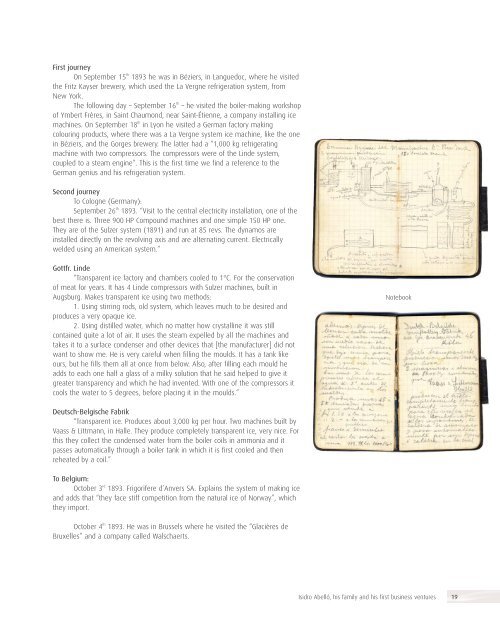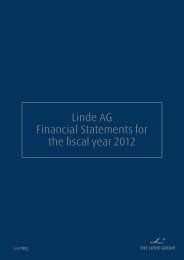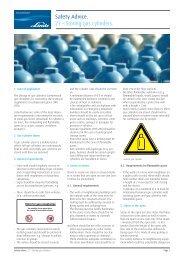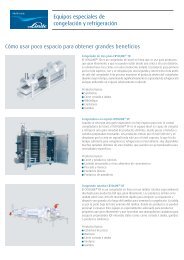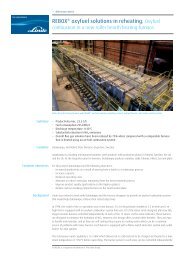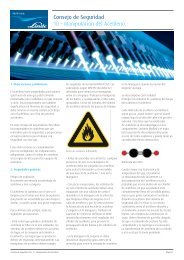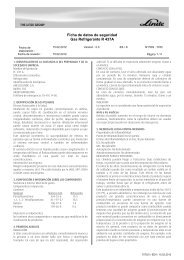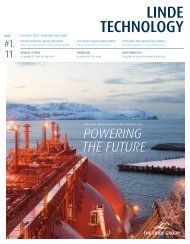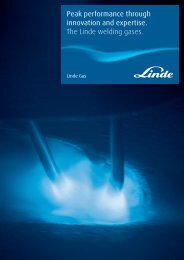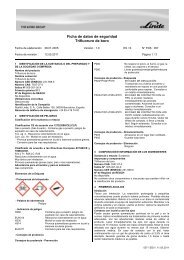Abelló Linde Centenary Book
Abelló Linde Centenary Book
Abelló Linde Centenary Book
You also want an ePaper? Increase the reach of your titles
YUMPU automatically turns print PDFs into web optimized ePapers that Google loves.
First journey<br />
On September 15 th 1893 he was in Béziers, in Languedoc, where he visited<br />
the Fritz Kayser brewery, which used the La Vergne refrigeration system, from<br />
New York.<br />
The following day – September 16 th – he visited the boiler-making workshop<br />
of Ymbert Frères, in Saint Chaumond, near Saint-Étienne, a company installing ice<br />
machines. On September 18 th in Lyon he visited a German factory making<br />
colouring products, where there was a La Vergne system ice machine, like the one<br />
in Béziers, and the Gorges brewery. The latter had a “1,000 kg refrigerating<br />
machine with two compressors. The compressors were of the <strong>Linde</strong> system,<br />
coupled to a steam engine”. This is the first time we find a reference to the<br />
German genius and his refrigeration system.<br />
Second journey<br />
To Cologne (Germany):<br />
September 26 th 1893. “Visit to the central electricity installation, one of the<br />
best there is. Three 900 HP Compound machines and one simple 150 HP one.<br />
They are of the Sulzer system (1891) and run at 85 revs. The dynamos are<br />
installed directly on the revolving axis and are alternating current. Electrically<br />
welded using an American system.”<br />
Gottfr. <strong>Linde</strong><br />
“Transparent ice factory and chambers cooled to 1°C. For the conservation<br />
of meat for years. It has 4 <strong>Linde</strong> compressors with Sulzer machines, built in<br />
Augsburg. Makes transparent ice using two methods:<br />
1. Using stirring rods, old system, which leaves much to be desired and<br />
produces a very opaque ice.<br />
2. Using distilled water, which no matter how crystalline it was still<br />
contained quite a lot of air. It uses the steam expelled by all the machines and<br />
takes it to a surface condenser and other devices that [the manufacturer] did not<br />
want to show me. He is very careful when filling the moulds. It has a tank like<br />
ours, but he fills them all at once from below. Also, after filling each mould he<br />
adds to each one half a glass of a milky solution that he said helped to give it<br />
greater transparency and which he had invented. With one of the compressors it<br />
cools the water to 5 degrees, before placing it in the moulds.”<br />
Notebook<br />
Deutsch-Belgische Fabrik<br />
“Transparent ice. Produces about 3,000 kg per hour. Two machines built by<br />
Vaass & Littmann, in Halle. They produce completely transparent ice, very nice. For<br />
this they collect the condensed water from the boiler coils in ammonia and it<br />
passes automatically through a boiler tank in which it is first cooled and then<br />
reheated by a coil.”<br />
To Belgium:<br />
October 3 rd 1893. Frigorifere d’Anvers SA. Explains the system of making ice<br />
and adds that “they face stiff competition from the natural ice of Norway”, which<br />
they import.<br />
October 4 th 1893. He was in Brussels where he visited the “Glacières de<br />
Bruxelles” and a company called Walschaerts.<br />
Isidro Abelló, his family and his first business ventures 19


